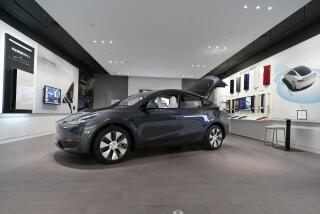Your next car may want to steer itself
- Share via
When military pilots steer a jet fighter, the stick in the cockpit is not mechanically connected to the rudder or any other control surfaces. Most motorists would have a hard time accepting that kind of electronic system in their car, preferring to know that the steering wheel in their hand is physically linked to the front wheels.
It may be reassuring, but this comfort factor could be ending as the era of electric steering nears. “Electric steering is very close,” said Phil Headley, chief engineer for advanced technologies at Continental Automotive Systems, a major supplier of vehicle steering systems.
Steering systems will dispense with mechanical linkages and operate by wire within 10 years, predicts Ed Arbitter, chief of Delphi Corp.’s electric steering business. “It is not so much an issue of technology, but what consumers and government regulators are comfortable with,” he said.
The current generation of four-wheel steering systems already uses computers, electric motors and wires to steer the rear wheels. And Delphi has fielded experimental vehicles that have demonstrated a steer-by-wire system on front wheels. Engineers are optimistic that such systems can reduce vehicle costs and substantially enhance stability, reducing crashes and highway fatalities.
Parts of such futuristic systems already are appearing. The new Chevrolet Malibu and several European models, for example, have replaced hydraulic power systems with electric motors.
Delphi estimates that a complete steer-by-wire system that operates the front and rear wheels would reduce assembly costs and ultimately prices for consumers.
It also would reduce the loads on engines, because hydraulic assisted steering requires the belt-driven pump to work continuously. Eliminating the pump, hoses, pulleys and drive belt also would reduce weight and improve fuel efficiency by about 4%.
But most important, the systems would facilitate a major improvement in electronic stability control. Current systems use sensors to measure directional forces and acceleration, as well as steering wheel position and vehicle speed. If the software determines the car is out of control, it selectively applies front braking or reduces engine speed. Essentially, the computer is using the brakes to help steer the car. But with electric steering, the computer also would turn the wheels to help maintain control.
You might think the computer should mind its own business and let you make the decisions, but the stakes are incredibly high.
If the current generation of electronic stability control systems was widely used it could reduce single vehicle crashes by an estimated 30%, saving 5,000 lives a year, according to a Mercedes-Benz study.
What’s the downside to electric steering? You can imagine what would happen if the car’s central computer has a glitch. Theoretically, it could turn the steering off or send your car into a bridge abutment.
But the auto industry has a record of producing car computers that make the personal computer industry look like a bunch of incompetents. Car computers boot up instantly and almost never simply lock up in a way that compromises safety.
Steer-by-wire is part of a big evolution to electric systems on gas-powered vehicles that includes electric air conditioning, water pumps, engine valves and even brakes. But getting there will require higher voltage electrical systems packing 36 volts, a development that is just a few years away.
E-mail: ralph.vartabedian@latimes.com.
More to Read
Inside the business of entertainment
The Wide Shot brings you news, analysis and insights on everything from streaming wars to production — and what it all means for the future.
You may occasionally receive promotional content from the Los Angeles Times.










